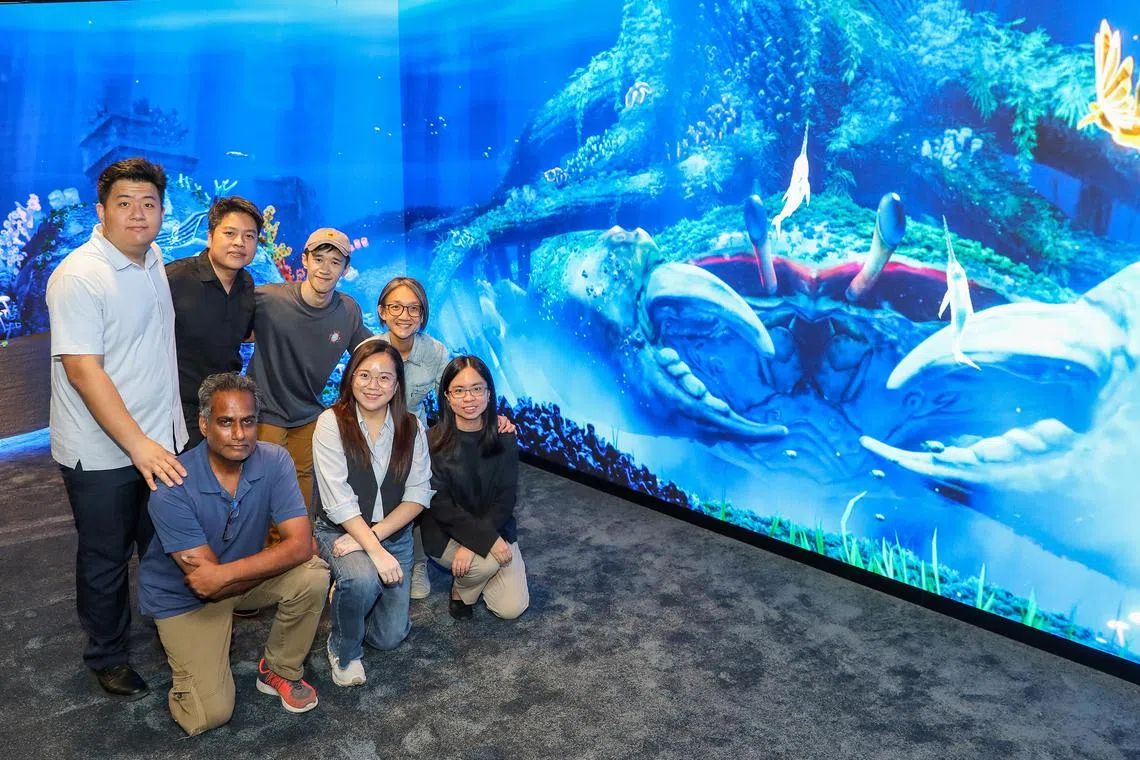Facts and myths intersect at the National Museum’s new glass rotunda installation
Sign up now: Get ST's newsletters delivered to your inbox

A multidisciplinary team worked on the glass rotunda's latest permanent display, Singapore Odyssea.
ST PHOTO: LUTHER LAU
Follow topic:
- The National Museum of Singapore's Shaw Foundation Glass Rotunda re-opens on August 8 with "Singapore Odyssea", a new permanent exhibition about Singapore's 700-year history.
- The multimedia display uses myths and historical "trauma points" with projections and sound recordings to create an immersive "travel back in time" experience.
- The musem's Singapore History Gallery closes for a year-long revamp on November 16, with Level Two galleries slated to re-open in 2026 after their refresh.
AI generated
SINGAPORE – In one popular myth passed down in Malay folklore, tidal changes are explained by a massive crab that resides among the roots of a magical tree named pauh janggi.
The tree is above pusat tasek – or “navel of the ocean” in Malay – and the crab’s daily forays in and out of this gaping hole in the ocean floor are said to cause the rise and fall of the seas.
This myth will be one of the stories told with the use of animation at the National Museum of Singapore’s (NMS) Shaw Foundation Glass Rotunda, which reopens on Aug 8 after closing in October 2024 for a revamp.
The glass rotunda’s new permanent exhibition, Singapore Odyssea, traces about 700 years of Singapore’s history, culminating in a transition zone between the rotunda and the Singapore History Gallery.
In addition to pauh janggi, three other myths are presented in this zone: Sang Nila Utama, the Palembang prince who supposedly named Singapore; the swordfish attack that gave Bukit Merah its name; and Raja Chulan, a Chola king who is said to have explored the waters near Singapore in a diving bell.
Multidisciplinary artist Brian Gothong Tan, Singapore Odyssea’s multimedia creative director, said the display incorporates myths as they are the lifeblood of civilisations.
Mr Tan – whose experimental film Waking The Fluorescent Lion was screened in the rotunda as part of the NMS’ opening festival in December 2006 – said Singapore Odyssea goes beyond the traditional colonial understanding of the city by mixing ancient maritime history with myths.
It’s “an expansion of our collective consciousness”, he said.
Ms Priscilla Chua, principal curator at the NMS, said: “Myths have long existed even before history was recorded.”
She added: “Before the written word, this was what communities and people held onto, and what enabled them to understand what’s going around them within the region, and help them to understand who they are, in the past and present.”

A designer from local animation studio CraveFX working on the designs for pauh janggi, a mythical tree.
ST PHOTO: LUTHER LAU
Ms Chua said that Singapore Odyssea is designed to be an immersive multimedia experience that creates a “visually inspiring depiction of Singapore’s history”, with an emphasis on visuals.
“It’s meant to be experiential, rather than artefacts,” she said.
“We wanted visitors to have a 30-minute teaser of Singapore’s history, before they enter the Singapore History Gallery to see the actual objects that depict the country’s history.”
The glass rotunda’s reopening marks the completion of the first phase of an ongoing overhaul of the NMS’ permanent galleries
The Singapore History Gallery will admit its last visitors on Nov 16 before undergoing a year-long revamp, while the five galleries on level two closed in September 2023 for a refresh.
These galleries are slated to reopen in 2026.
Ms Melissa Chan, Singapore Odyssea’s art and design director, said the display begins by showcasing Singapore’s maritime connections with the world through a new LED-covered sphere that represents the globe.

An artist’s impression of the new LED sphere in the National Museum of Singapore’s glass rotunda.
PHOTO: CRAVEFX, GSM PROJECT, KIN PRODUCTIONS AND NATIONAL MUSEUM OF SINGAPORE
Referencing the glass rotunda’s previous exhibit Story Of The Forest – designed by Japanese firm teamLab and displayed from 2016 to 2024 – Ms Chan said the only major physical change is Singapore Odyssea’s new sphere, which helps to highlight the geometry and structure of the rotunda.
After passing under the sphere, visitors will make their way down a ramp, alongside projections that depict Singapore’s history in reverse chronology.
Mr Joshua Tan, the new exhibit’s multimedia director, said this gives visitors a sense that they are digging deeper into the past, while their walk downwards on the ramp brings across the idea of excavation.
In conceptualising the narrative for this section’s projection, Mr Brian Gothong Tan said the team looked at “trauma points” in Singapore’s history, such as the separation from Malaysia and colonisation.
He said the design of projections here was inspired by temple reliefs in places such as Angkor Wat in Cambodia.

The team that worked on Singapore Odyssea includes (from left to right) National Museum of Singapore principal curator Priscilla Chua, creative director Brian Gothong Tan, art and design director Melissa Chan and multimedia director Joshua Tan.
ST PHOTO: LUTHER LAU
At the end of the ramp, visitors enter a space within the rotunda where they can view vignettes of Singapore’s history, before moving into the transition zone where the four myths are showcased.
Mr Joshua Tan said that while the visuals displayed in the zone are animated, artists drew inspiration for them from real-life examples.
For instance, he said, the team went on intertidal walks to conceptualise the animations for the transition zone, where the team presented pauh janggi as a mangrove tree, and also incorporated locally found species into their designs, such as hawksbill turtles, ribbon jellyfishes and gold-spotted mudskippers.
This, he said, makes the display a mix of myths and reality, while Mr Brian Gothong Tan said the depiction of wildlife nudges visitors to consider humans’ relationship with the natural world, especially as Singapore has lost much of its natural landscape during the colonial era.
An original soundtrack that incorporates sound recordings from around Singapore was composed for Singapore Odyssea.
Mr Zahin Anwari, the display’s lead sound designer, said the soundtrack includes singers from as far away as Bulgaria and Egypt, who were sought for the tonality and exoticism of their voices.
Ms Chua hopes the “travel back in time” experience that the rotunda offers will pique visitors’ curiosity about Singapore’s history.
“The concept of time travel has always had the allure of mystery, excitement and adventure and that’s precisely the kind of experience we want to create for visitors,” she said.


